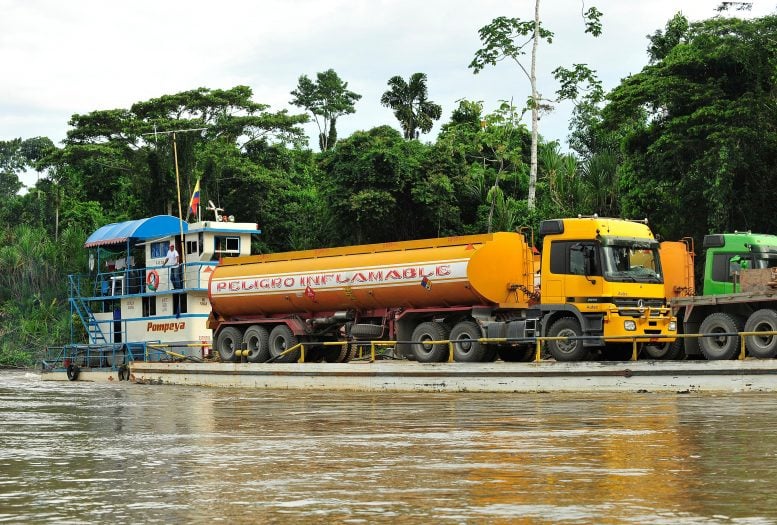Intact Forest Landscapes are critical for conserving biodiversity and fighting climate change.
A new study from WCS and WWF reveals that nearly 20 percent of tropical Intact Forest Landscapes (IFLs) overlap with concessions for extractive industries such as mining, oil and gas. The total area of overlap is 376,449 square miles (975,000 square kilometers), about the size of Egypt. Mining concessions overlap most with tropical IFLs, at 11.33 percent of the total area, while oil and gas concessions overlap with 7.85 percent of the total area.
IFLs are globally important for conserving biodiversity and fighting climate change. These landscapes represent some of the last places on Earth that still contain species assemblages at near-natural levels of abundance. According to 2013 estimates, 549 million acres of intact tropical forests remain. Only 20 percent of tropical forests can be considered “intact,” but those areas store some 40 percent of the above-ground carbon found in all tropical forests. At least 35 percent of intact forests are home to, and protected by, politically and economically marginalized Indigenous Peoples.
Despite intact forests’ extraordinary value for biodiversity and humanity, they are declining at an alarming rate, with over 7 percent of their total area lost between 2000 and 2013. While the growth of extractive industries is recognized as a threat to IFLs, the extent of this threat has not been well understood prior to this study.
The authors calculated the spatial overlap of extractive concessions – specifically, mining, and oil and gas – with IFL datasets in three tropical regions: South America, Asia-Pacific, and Central Africa. Of these regions, Central Africa’s IFLs had the highest overlap with extractive concessions (26 percent). In addition, they identified the specific stages of extractive projects overlapping with IFLs, and found that most leases are in the exploration stage.
Said Dr. Hedley Grantham, lead author of the study. “Many of these extractive projects are still in the early stages. While this could imply a significant future threat to IFLs, it also means there is an opportunity to mitigate potential impacts before they occur.”
The authors recommend that companies incorporate avoidance planning in the design phase of extractive projects, taking into account the most important intact forest areas. Ideally, coordination with governments will allow for landscape-scale planning. The authors encourage governments not to allocate extractives concessions within IFLs where possible. With the appropriate planning, future impacts to these crucial ecosystems can be avoided.
The study is published in Frontiers in Forests and Global Change.
Reference: “The Emerging Threat of Extractives Sector to Intact Forest Landscapes” by Hedley S. Grantham, Paolo Tibaldeschi, Pablo Izquierdo, Karen Mo, David J. Patterson, Hugo Rainey, J. E. M. Watson and Kendall R. Jones, 16 July 2021, Frontiers in Forests and Global Change.
DOI: 10.3389/ffgc.2021.692338
WCS is a member of Forests for Life (FFL), a partnership with Re:wild, United Nations Development Programme, World Resources Institute and Rainforest Foundation Norway. Working with national governments, Indigenous Peoples, local communities and others, FFL has two aims – to place ecological integrity at the heart of managing and conserving the world’s forests and to halt and reverse declines in integrity across 1 billion hectares of the most intact forests worldwide.
WCS is a proud partner of Trillion Trees, a joint venture between BirdLife International, WCS, and WWF to urgently speed up and scale up the positive power of forests, helping the world protect and restore one trillion trees by 2050.










I think that it is appropriate to take the long view on this situation. At one time, almost all of the level land of New England was under cultivation after the native forests were cut down. When the marginal farms were abandoned, the forest grew back. Today, it is common to be walking in the woods in New England and come across old rock walls and house foundations.
Once the extractive industries have exhausted the subsurface resources, most modifications of these tropical Intact Forest Landscapes will heal, and only experts would probably be able to tell they were ever disturbed. Indigenous people have practiced slash and burn agriculture for thousands of years. What we consider to be ‘natural’ may actually be the result of human influence even today.
Probably a greater threat to the survival of the IFLs is logging and agricultural expansion to feed growing populations. Mining and oil and gas extraction have a smaller impact on the landscape than logging and agriculture. The largest open-pit metal mines in the world are typically only about a mile in diameter. A single farm or ranch may well extend for several miles in length and width.